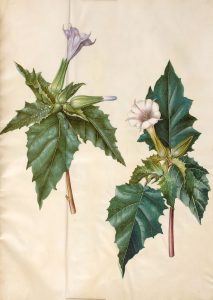
My journal reads as follows; There are several species of this plant as discussed at https://www.gyanunlimited.com/
And https://www.ncbi.nlm.nih.gov/
Datura wrightii, also called Southwestern Thorn Apple
Datura stramonium, also called Jimson weed
Datura metaloides also called sacred datura
Datura inoxia named as Toloache
Datura discolor is also known as Moonflower.
Datura ceratocaula
Datura ferox: long-spined thorn-apple
Datura leichhardti: Leichhardt’s datura
Datura quercifolia: Oak-leaf thorn-apple

All parts of the Datura contain a dangerous level of alkaloids such as scopolamine, hyoscyamine, and atropine which are anticholenergics that block and inhibit the activity of the neurotransmitter acetylcholine (ACh) at both central and peripheral nervous system synapses.
To demonstrate how strong datura is, a brew/tea of only 2-3 leaves are enough for 30 to 40 people. Though very toxic, Datura has also been used for respiratory problems, as a sedative, for motion sickness, asthma, and as anesthesia, an anti-spasmodic, and a hypnotic. Smoking blends of datura and cannabis are used for sleep and pain with some mind-altering effects. Keep in mind, Datura is also a nervous system depressant.
Since this very basic knowledge in 2010, I have come to know more about Datura with its stunning flowers. It is helpful in the garden as it keeps unwanted insects away, but Datura stramonium is a hallucinogenic plant found in the urban and rural areas, along roadsides, in cornfields and pastures. The range of toxicity of Datura stramonium is highly variable and unpredictable. It occurs at higher doses when ingested, smoked and absorbed topically. Yes, just touching this plant can have an effect, which is why most do not have it in their gardens out of concern for pets and kids. This is why only half of one leaf is used in smoking blends if used at all.
Dose is everything when working with baneful herbs. Many toxic plants also have medicinal uses, but the caution comes in how confident are you about how strong your mixture is and how willing you are willing to take that chance.
I have a tincture of datura I keep on hand in case of an emergency. Living out in the country, animals are harmed fatally yet still suffering. I have in my past had to shoot such animals, which is difficult to bear. I much prefer the idea of putting them out of their misery with a tincture that will ease their pain as they pass. All plants have some use.
Next time in herbalism for your day is Magical Aroma Therapy, so stay tuned for that and many blessings to all!
 Cat Gina Cole is a Herditary Witch and author of Psychic Skills for Magic and Witchcraft (Llewellyn, 2022). She is the founder of The Coven of the Rising Phoenix and Staff Coordinator for “Green Egg Magazine.” You can reach her at www.catginacole.com.
Cat Gina Cole is a Herditary Witch and author of Psychic Skills for Magic and Witchcraft (Llewellyn, 2022). She is the founder of The Coven of the Rising Phoenix and Staff Coordinator for “Green Egg Magazine.” You can reach her at www.catginacole.com.